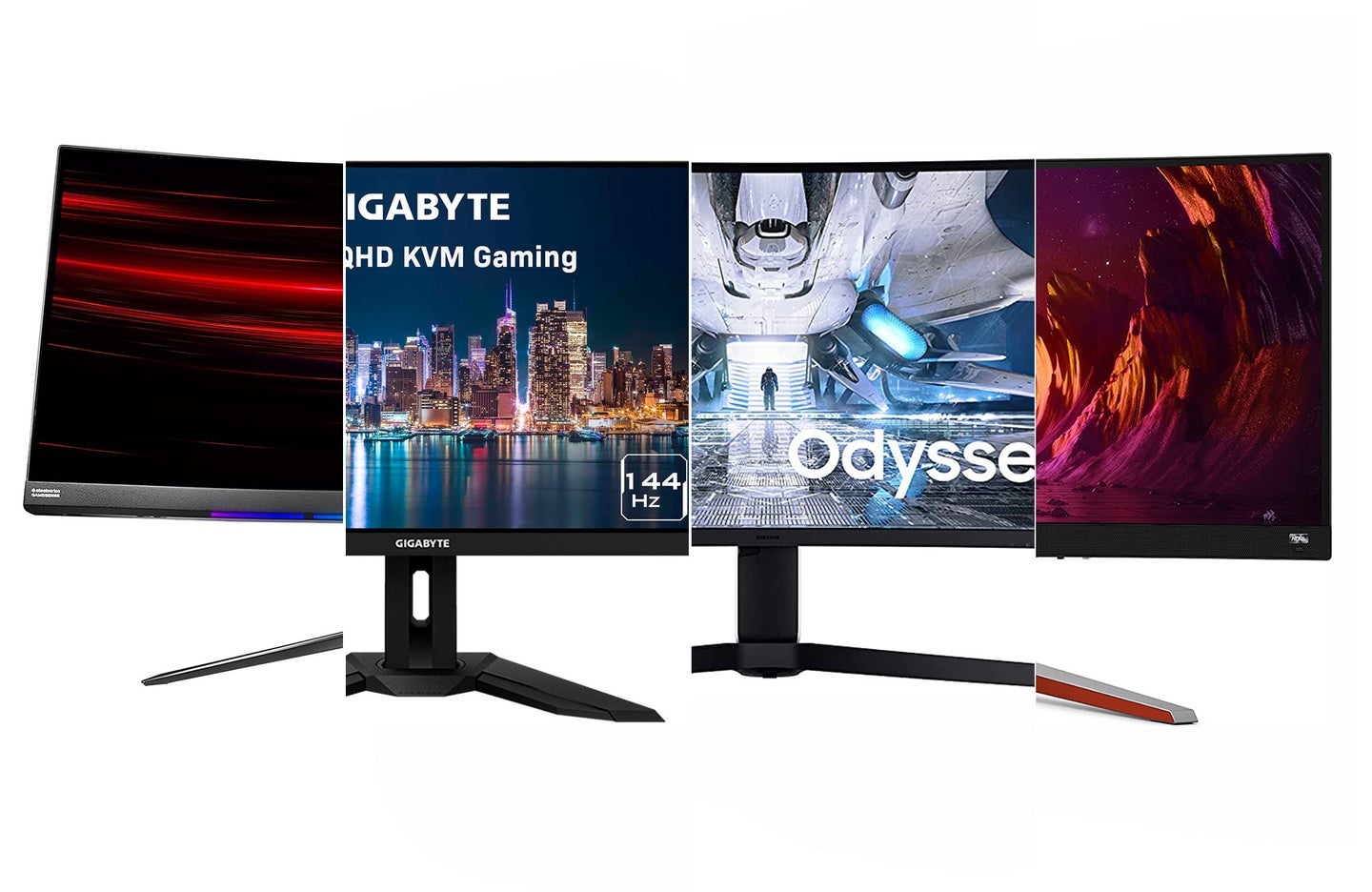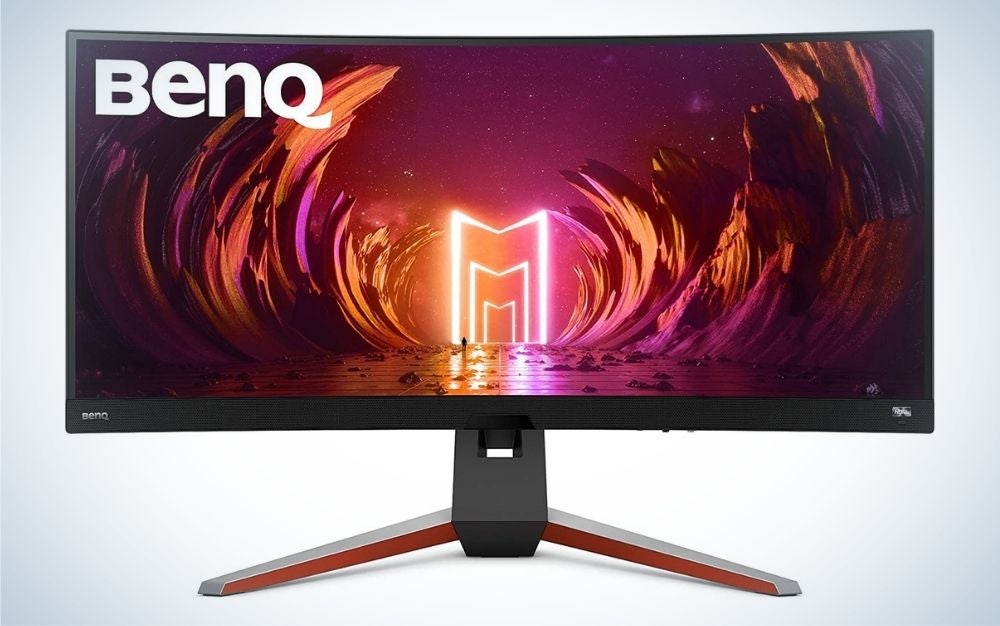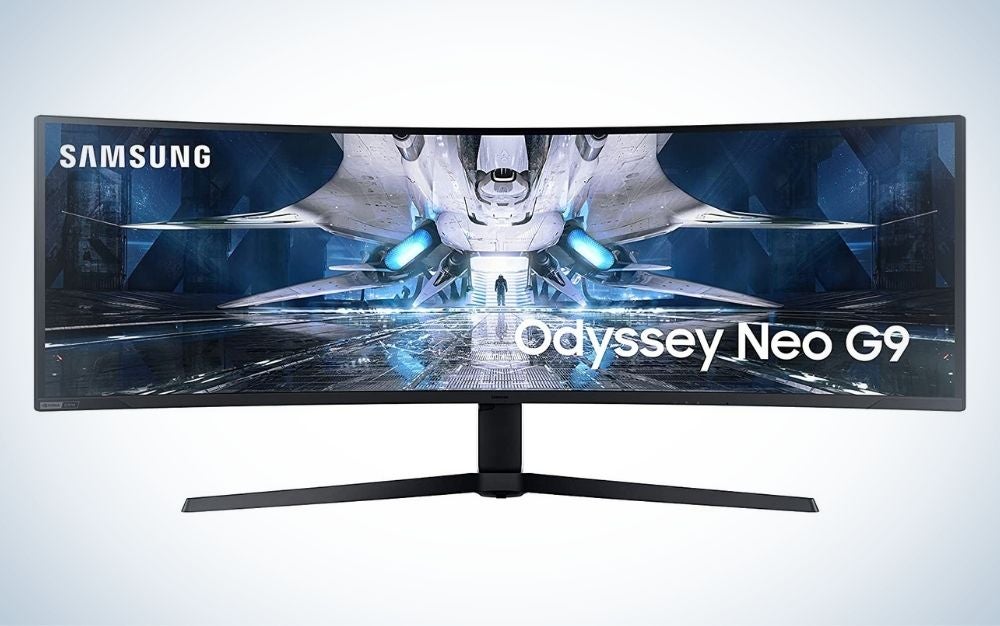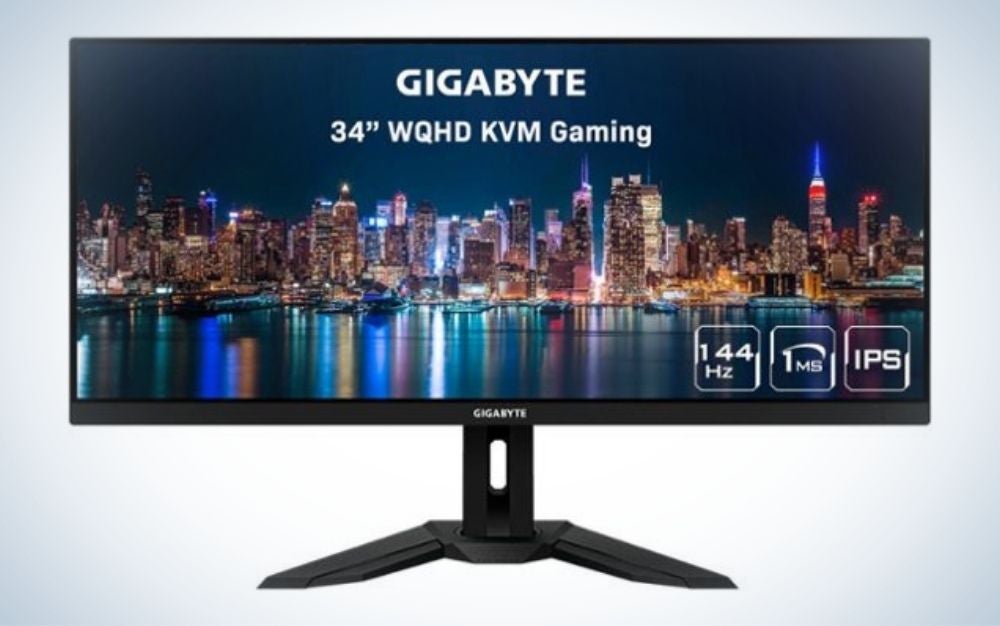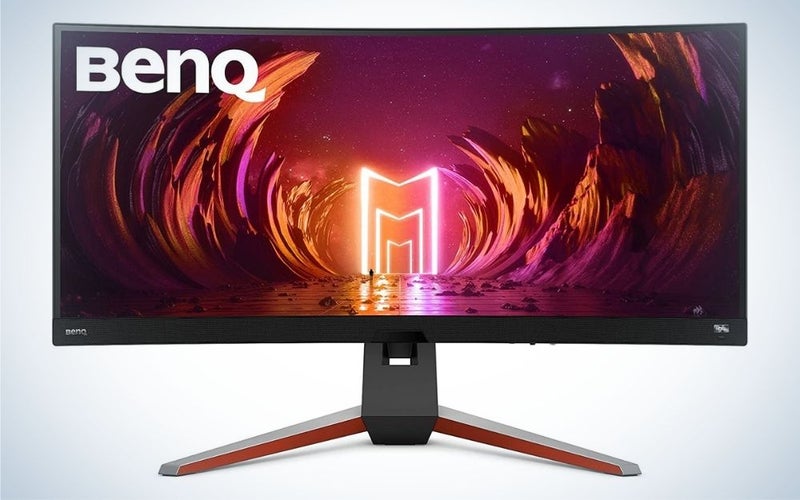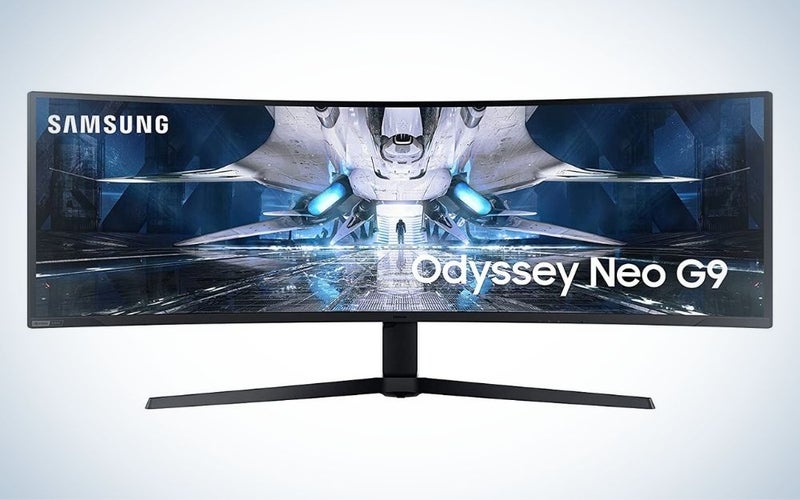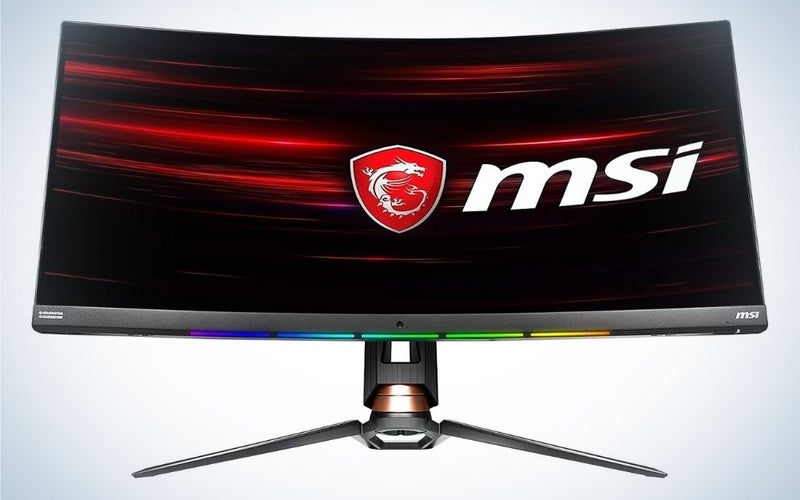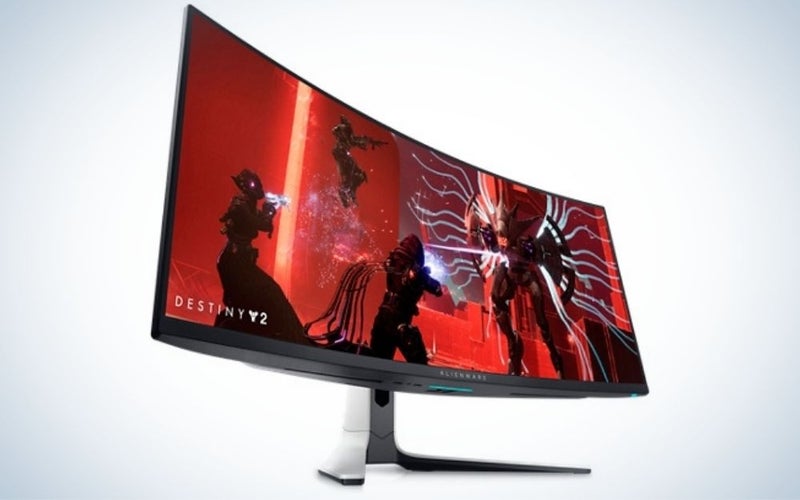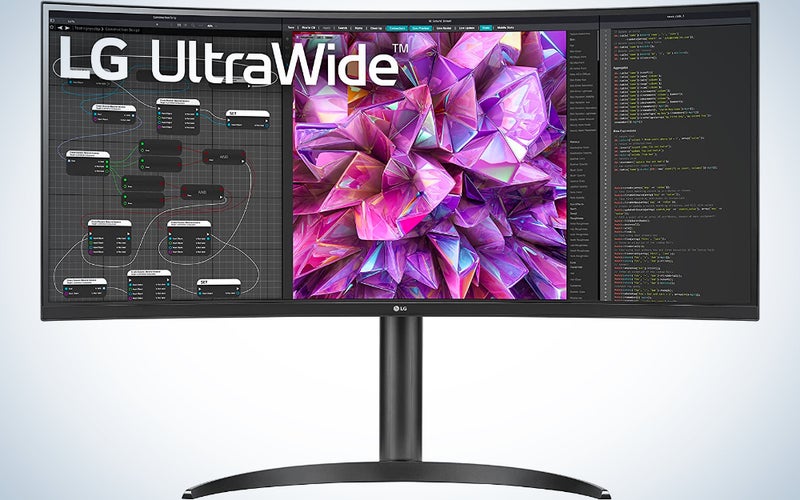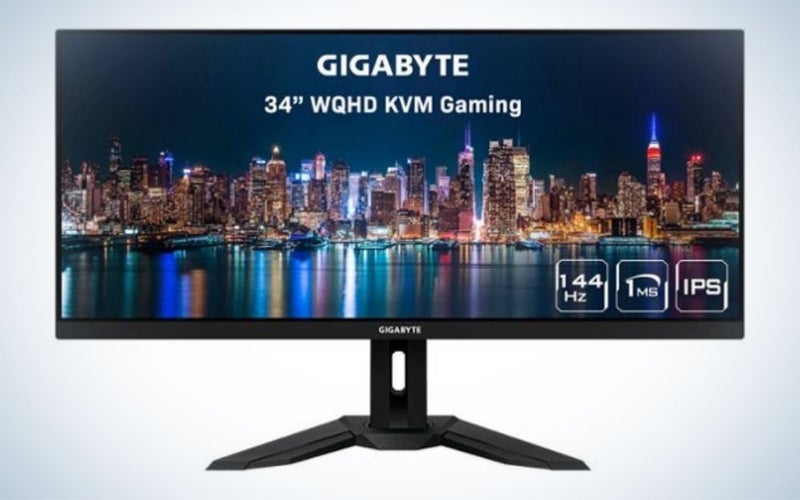We may earn revenue from the products available on this page and participate in affiliate programs. Learn more ›
If you want to completely lose yourself in a video game, an ultrawide gaming monitor is one of the best ways to expand your PC gaming setup. Standard widescreen is great, but ultrawide displays eliminate the need for a secondary display with a giant screen that stretches all the way across your field of vision. Just as with any other category of monitors, though, there are tons of options to choose from, and not all of them will get you what you need. We’ll walk you through the detailed decisions that go into picking the best ultrawide gaming monitors, then highlight some of the best options available in the space.
- Best overall: BenQ Mobiuz EX3415R
- Best super ultrawide: Samsung Odyssey Neo G9
- Best for consoles: MSI Optix MPG 341CQR
- Best OLED: Alienware 34 QD-OLED AW3423DW
- Best for Mac: LG 34WQ73A-B
- Best budget: Gigabyte M34WQ
How we chose the best ultrawide gaming monitors
For a long time, the biggest change in PC monitors was the shift from old CRT screens to flat panel displays. In the last five or 10 years, though, they’ve begun to evolve at a breakneck pace. There are more options than ever now. I’ve been covering both display and GPU technology for the last five years, in addition to building my own PCs and paying attention to new developments in graphics technology as a personal hobby.
To make our selections, we drew upon our monitor testing program, sourced opinions from critics at multiple publications and user impressions from across the internet, and leveraged our general knowledge of display technology. We looked for interesting monitors to fit a few different categories. There’s no price limit on our picks, which means these displays can range anywhere from a few hundred dollars to a few thousand.
The best ultrawide gaming monitors: Reviews & Recommendations
Flat or curved, big or small—it’s time to figure out the best ultrawide monitor for your gaming rig, whether a desktop PC or a laptop. After doing our homework, we think these are top options you can get right now, from the best overall to the very best that money can buy to the best for less, as well as an option that was announced earlier this year that we’re really looking forward to taking for a spin.
Best overall: BenQ Mobiuz EX3415R
BenQ
Why it made the cut: The BenQ Mobiuz EX3415R has all the big bells and whistles we look for without the heavy price tag.
Specs
- Panel type: IPS
- Native resolution (Aspect Ratio): 2560×1440 (21:9)
- Panel style: Curved (1900R)
- Color depth: 10-bit
- Refresh rate: 144 Hz
- Response time: 1ms
- Max brightness: 200 nits (typical) / 400 nits (max)
- Ports: 1 x DisplayPort 1.4; 1 x HDMI 2.0; 2 x USB 3.0 Type-A
- Ergonomics: Tilt, Height, VESA 100mm mountable
- Variable refresh rate: Nvidia G-Sync Compatible/FreeSync
- HDR: HDR10, VESA HDR 400
Pros
- Loud built-in soundbar
- Robust feature set
- Lots of color options
- Great value
Cons
- Low brightness
The BenQ EX3415R has it all. This IPS panel offers a 144 Hz refresh rate for fast response in games, 10-bit color to display images accurately, and a gentle 1900R curvature for easy viewing. Add a good set of ports and both G-Sync and FreeSync compatibility, and you have a more or less complete package.
It was hard to pick between the EX3415R and the Alienware AW3420DW—another excellent curved ultrawide display—but the BenQ panel wins out thanks to a higher refresh rate and higher peak brightness. Both models offer great performance and incredible value, though: To get bigger or sharper, you’ll have to spend a lot more money.
Best super ultrawide: Samsung Odyssey Neo G9
Samsung
Why it made the cut: The Samsung Odyssey Neo G9 outshines every other ultrawide with its giant, rich display … and its sky-high price tag.
Specs
- Panel type: VA
- Native resolution (aspect ratio): 5120 x 1440 (32:9)
- Panel style: Curved (1000R)
- Refresh rate: 240Hz
- Response time: 1 ms
- Max brightness: 420 nits (Typical) / 2000 nits (Max)
- Ports: 1 x DisplayPort 1.4; 2 x HDMI 2.1; 2 x USB 3.0 Type-A; Earphone Jack; Audio line-out
- Ergonomics: Height, Swivel, Tilt, VESA 100mm mountable
- Variable refresh rate: Nvidia G-Sync Compatible/AMD FreeSync
- HDR: HDR10+
Pros
- Massive screen
- Top-tier gaming features
- HDMI 2.1
Cons
- Super expensive
If you can afford the $2,500 price tag, the Samsung Odyssey Neo G9 is as good as it gets when it comes to ultrawide displays. The 49-inch, 32:9 screen is quite literally the same screen (and desk) real estate as two displays pushed together, and the 1000R curve allows the display to surround you with bright, vibrant colors whenever you boot up a game. The G9 has tons of ports, including two HDMI 2.1 ports—the only screen on this list that offers them (so you’ll want to pick up the best ultra-high-speed HDMI cables). You could put this screen in almost any category on this list and have it make sense. It’s just that good. You just have to come up with the money to bring it home.
Best for consoles: MSI Optix MPG 341CQR
MSI
Why it made the cut: The MSI Optix MPG 341CQR is the only ultrawide gaming monitor with console-minded features.
Specs
- Panel type: VA
- Native resolution (aspect ratio): 3440 x 1440 (32:9)
- Panel style: Flat
- Color depth: 10-bit
- Refresh rate: 144 Hz
- Response time: 1 ms
- Max brightness: 400 nits
- Ports: 1 x DisplayPort 1.4; 2 x HDMI 2.1; 3 x USB 3.2 Gen2 Type-A; Earphone Jack
- Ergonomics: Height, Swivel, Tilt, VESA 100mm mountable
- Variable refresh rate: Nvidia G-Sync Compatible/AMD FreeSync
- HDR: VESA HDR 400
Pros
- Console optimization
- Robust features
- Good price
Cons
- Consoles don’t support ultrawide aspect ratios directly
I’ll be blunt: We do not recommend pairing a PlayStation 5 or Xbox Series X with an ultrawide gaming monitor. Right now, only the PS5 supports ultra-wide monitors at 1440p, and it only gained support for variable refresh rates in mid-2022. Many TVs for gaming are far more optimal.
That said, we do have an option if you feel compelled. MSI claims that the Optix MPG 341CQR is optimized specifically for PS5. According to the company, it will accept a 4K signal and downsample it to 1440p rather than upscaling a 1080p signal. This display also supports 120Hz gameplay at 1080p over HDMI—a nice feature for the small but growing number of console games that support it.
Beyond its PS5 compatibility, the Optix MPG 341CQR is a generally solid display. It offers good color depth, a high refresh rate, lots of USB ports, and a VA panel for good contrast in both well- and dimly-lit rooms.
Ultrawide screens are generally not a good fit with game consoles. If you need to play a PlayStation 5 or Xbox Series console into a display, this is your best bet.
Best OLED: Alienware 34 QD-OLED AW3423DW
Alienware
Why it made the cut: Alienware made the first QD-OLED gaming monitor, and they put it on a 21:9 display.
Specs
- Panel type: Quantum Dot OLED
- Native resolution (aspect ratio): 3440 x 1440 (21:9)
- Panel style: Curved (1800R)
- Refresh rate: 175Hz over DisplayPort, 100Hz over HDMI 2.0
- Response time: 0.1 ms
- Max brightness: 250 nits (typical) / 1000 nits (max)
- Ports: 1 x DisplayPort 1.4; 2 x HDMI 2.0; 4 x USB 3.2 Gen1 Type-A; Earphone Jack; Audio line-out
- Ergonomics: Height, Swivel, Tilt, Slant, VESA 100mm mountable
- Variable refresh rate: Nvidia G-Sync Ultimate
- HDR: VESA DisplayHDR True Black 400
Pros
- OLED display
- Great HDR support
- Lots of ports
Cons
- Burn-in might be a concern
Organic light-emitting diode display technology—OLED, for short—is arguably the king of the gaming television space right now, monitor manufacturers have been slow to bring the panels to the world of PCs. (For an in-depth explainer on why check out our list of the best OLED TVs.) In fact, Alienware just launched the first QD-OLED gaming monitor, the AW3423DW, giving PC gamers the chance to experience the heightened fidelity OLED displays can provide.
With an OLED display, you get perfect contrast thanks to the fact that every pixel is individually-self lit instead of being backlit or edgelit like traditional LED screens. That means pure blacks and vibrant colors, as well as super-fast response time. The Alienware AW3423DW seems to have its specs locked down, ensuring a gaming monitor worthy of the “first OLED” mantle.
While OLED screens are bright and beautiful, there are reasons for PC players to be skeptical. OLED TVs have historically been deeply susceptible to “burn-in,” a visual distortion where pixels become stuck displaying a certain shape after displaying it too long. Since many elements of a PC desktop are static on Windows 11 and macOS, there’s good reason to question whether OLED monitors would have a shorter lifespan than conventional monitors.
With Alienware launching an OLED screen, though, it seems like burn-in isn’t the worry it once was. One YouTuber attempted to burn an image into the new Nintendo Switch OLED’s screen but only created faint ghosting after 3,600 hours of showing the exact same image. In other words, if you use a screensaver or let your display sleep, you’re almost certainly fine.
Best for Mac: LG 34WQ73A-B
LG
Why it made the cut: The inclusion of a USB-C port makes it a breeze to connect this monitor to a Mac.
Specs
- Panel type: IPS
- Native resolution (aspect ratio): 3440 x 1440 (21:9)
- Panel style: Curved
- Refresh rate: 60Hz
- Response time: 5ms
- Max brightness: 300 nits
- Ports: 1 x USB-C (90W), 2 x USB-A (2.0), 1 x USB-B, 1 x Ethernet RJ45, 2 x HDMI 2.0, 1 x DisplayPort 1.4, 1 x 3.5mm Audio Out
- Ergonomics: Height, Swivel, Tilt, Slant, VESA 100mm mountable
- Variable refresh rate: N/A
- HDR: HDR 10
Pros
- USB-C port with video and charging
- Height and tilt adjustment
- USB-A ports make this monitor a hub
Cons
- Non 4K resolution
We know what you’re thinking: Macs aren’t good machines for gaming, but that’s definitely not as true as it once was (have you even seen the Mac Studio specs). The Apple Arcade library and new-to-Mac titles like Resident Evil VII mean the Mac is steadily becoming a more competent platform for casual and AAA games. This is possible because the company’s M-series processors are far more graphically capable than the Intel machines the company shipped over the past five years or so. Unfortunately, one of its other design decisions holds the Mac back when it comes to connecting them to an external display.
Apple went all-in on USB-C with the release of its 12-inch MacBook in 2015, and many of its current-generation laptops can only connect to accessories using this port. This means most Mac owners who want to plug their computer into an external display must buy an adapter. LG’s 34WQ73A-B is a notable exception. This curved monitor has a USB-C port, allowing you to plug your MacBook directly into it using a single cable. The 34WQ73A-B’s USB-C port serves a dual purpose, too: The cable can charge your MacBook at a rate of up to 90W while it’s connected, so this is a true single-cable solution.
LG outfitted this monitor with a pair of HDMI ports, which can plug in a media streamer or game console like a TV. The 34WQ73A-B’s USB-A ports will allow you to connect accessories—think webcam or external hard drive—to your machine without a hub. Gamers who use this external display will appreciate its support for HDR 10 and the ability to display 99% of the sRGB spectrum. Height and tilt adjustment will allow you to position this monitor in a place that’s comfortable for you without the need to attach it to a VESA mount. Its resolution is less than 4K, but that’s true for most ultrawide monitor. What you give up in vertical pixels, you gain in horizontal ones.
The 34WQ73A-B’s USB-C port is the reason we’re recommending this monitor specifically for Mac owners, but it’s also a solid choice for Windows machines. Many PCs have started shipping with USB-C or Thunderbolt 4 ports—they’re the same shape, and the latter can send more data more quickly—which means they’d reap the same benefits with this monitor as Macs. Apple has released its own 5K monitor for the Mac, but the $1,499 Studio Display is nearly five times as expensive as LGs. If you want a relatively inexpensive monitor with Mac-friendly features, this is the one we recommend.
Best budget: Gigabyte M34WQ
GIGABYTE
Why it made the cut: You won’t find a good ultrawide display cheaper than the Gigabyte M34WQ.
Specs
- Panel type: IPS
- Native resolution (aspect ratio): 3440 x 1440 (21:9)
- Panel style: Flat
- Color depth: 8-bit
- Refresh rate: 144Hz
- Response time: 1 ms
- Max brightness: 400 nits
- Ports: 1 x DisplayPort 1.4; 2 x HDMI 2.0; 2x USB 3.0; 1 x USB Type-C
- Ergonomics: Height, Swivel, Tilt, VESA 100mm mountable
- Variable refresh rate: Nvidia G-Sync Compatible/AMD FreeSync
- HDR: VESA HDR 400
Pros
- Killer price
- USB Type-C port
- A bright IPS display
Cons
- 8-bit color depth
- Skip the HDR
The Gigabyte M34WQ is the definition of a budget pick: It delivers strong features for just $500 but comes with some technical compromises. The M34WQ offers a solid set of gamer-focused features like a 144Hz refresh rate and compatibility with both G-Sync and FreeSync.
The cost of that low price is color depth. Most displays on this list feature 10-bit color, translating to over 1 billion colors. This is an 8-bit display with just 16.7 million. It’ll still look good, but you’re more likely to see color banding in some images. And don’t bother turning on the HDR. All that said, curved ultrawide gaming monitors don’t come cheap. You will be hard-pressed to find a better option at this price.
Things to consider before buying an ultrawide gaming monitor
There are a few things to remember as you pick out an ultrawide gaming monitor. Ultrawide displays, by definition, come in different aspect ratios than your average 16:9 widescreen monitor. Movies will feature black bars on the sides. Many apps, including games, will also if they don’t specifically support your screen size. Even when using apps that should work, ultrawide monitors require more tinkering than your average display. If the benefits still appeal, these are some things you should think about as you compare ultrawides.
Aspect ratio
Until the last couple of years, it was just a given that you’d want a standard widescreen display with a 16:9 aspect ratio. But now there are more options. In addition to 16:9, you’ll see lots of 21:9 (ultrawide) and a few 32:9 displays (super ultrawide) displays. Super ultrawide displays tend to be more expensive than ultrawide displays, and there are no cheap options: The prices start at $800 and go up rapidly. What you go with here comes down primarily to personal preference and budget. If you plan to game on this monitor, chances are that if your game supports 21:9, it will support 32:9 as well.
With that said, many apps and services do not support ultrawide displays. There are a lot of advantages to ultrawide, but that 33% increase in screen space also means that 33% of your screen will be black bars when watching Netflix fullscreen. Most games support 21:9 and 32:9, but it isn’t universal. They’ll still look fine, you’ll just see those black bars again.
Do you want a curved display?
Many people go for an ultrawide monitor rather than two screens that you can position independently because they specifically want a curved monitor. A curved display can enhance the immersion of your games, making it feel like the game world is surrounding you. Our faces, it turns out, aren’t flat … nor are our eyes. According to monitor manufacturer ViewSonic, curved monitors can actually reduce distortion by making the entire display the same distance from our eyes, and this is especially the case with ultrawide screens, which put the edges of the screen even further from our faces. The curve also makes these screens more comfortable for our eyes, ViewSonic said. In reducing distortion, they also reduce the amount of time spent dealing with distortion and with moving our heads and eyes to the corners of the screen.
With that said, curved screens are a bit of an acquired taste. They require more work to set up and optimize for individual games and software. They may also be more susceptible to glare than flat panels. The impact of both the upsides and the downsides comes down to personal taste. If you can, we recommend popping into your local electronics retailer and checking out a couple of curved monitors for yourself before making a decision.
Finding the right curve
If you decide to go with a curved display, you’ll need to think about how deep a curve you actually want. Some curved monitors bend lightly, giving you only the slightest sense that the screen forms around you. Others have a deep curve that makes you feel like you’re sitting in a cockpit. A monitor’s curve is measured by the radius of the monitor (R).
It may be counterintuitive for those who’ve forgotten high school geometry, but a lower radius indicates a more pronounced curve. The Samsung Odyssey Neo G9, for example, sports a 1000R curve, making it one of the most deeply curved screens. Most ultrawide monitors sport a curvature of 1500-1800R, but very lightly curved displays reach as high as 3000R.
The radius of the monitor also indicates the recommended viewing distance, or how far away you should sit from it for the ideal viewing experience. Viewing position is especially important for curved displays, as sitting at the right distance, in front of the center of the display, guarantees that you see the full effect of the curve.
Brightness, color depth, and HDR
Beyond curve-related considerations, there’s a range of specs to consider when picking any gaming monitor. Picking among ultrawide gaming monitors limits your options for many display considerations, making them a secondary concern. That said, it never hurts to check and compare.
Gaming monitors are made with three different types of LCD panels—Vertical Alignment (VA), In-Plane Switching (IPS), and Twisted Nematic (TN). When shopping for ultrawide displays, you’ll typically find IPS or VA panels. IPS panels offer brighter, more vibrant colors, while VA panels typically have better contrast. Both panel types have great refresh rates. If there are any TN panels on Ultrawide screens, we didn’t find them during our research. Those panels have the fastest refresh rates but have poor viewing angles and color reproduction, making them ill-suited to this particular task.
Brightness is also a major concern; look for something at least 300 nits(cd/m2) for peak brightness. Any lower and you may struggle in particularly dark scenes of games. High-Dynamic Range, or HDR, isn’t widely implemented on ultrawide gaming monitors. Fewer than one-third of the ultrawide monitors on Newegg feature HDR support. On top of that, HDR isn’t always implemented as well as it is in TVs. Regardless of screen size, Windows isn’t as good at knowing when to switch between HDR and SDR. As a result, HDR is a nice luxury, but shouldn’t make or break your monitor selection.
For more in-depth explanations of monitor specs, including brightness, HDR, panel type, and more, check out the things to consider in our rundown of the best cheap gaming monitors.
Use case
Even when buying “gaming” gear, not many people use our PCs just for one thing. Are you going to use this computer for gaming primarily, or will you also be using it for work? If your monitor will just serve up games and the web, you can focus purely on refresh rate and gaming-focused features. If you’re creating content or using it for office work, you should also consider technical elements, such as color accuracy or blue light reduction. In general, it pays to take a holistic approach to picking out gear rather than focusing on one specific use, even if that use is more fun.
FAQs
Q: Are ultrawide monitors good for gaming?
Ultrawide monitors can be great for gaming, especially curved displays. A curved display will fill your field of vision more completely and, in theory, requires less head movement to view completely.
Q: Do 4K ultrawide monitors exist?
Not really. The term 4K refers to a specific resolution, 3840×2160, which you can only create with 16:9 displays. Thus, 4K and Ultrawide are two separate categories of display that can’t really meet. There are a few 2160p Ultra widescreen displays, but they have a wider resolution of 5120, so they don’t count as 4K. That said, you could display a 4K image on that screen without distortion.
Q: Is a 34-inch ultrawide monitor big enough?
Definitely. Most displays on this list measure 34 inches, and the only one bigger is classified as a Super Ultrawide. If you’re buying an ultrawide monitor, it’ll likely be 34 inches.
Q: How much does an ultrawide monitor cost?
This will depend on its features, but many ultrawide monitors cost under $500.
Q: Is it better to have two monitors or one ultrawide?
A two-monitor setup is more efficient for creative workflows—photo or video editing, writing, and general computing tasks—as it’ll allow you to dedicate an entire separate screen to chat or e-mail apps that need to be monitored while you’re working. Gaming is a single-screen activity, so a single ultrawide monitor makes more sense.
Q: What is the best size for an ultrawide monitor?
Most ultrawide monitors are between 32 and 34 inches in size, which are well-suited for gaming. A larger monitor will be more difficult to see.
Q: Does ultrawide affect FPS?
No, the graphics card and processor in your computer and the games you play will have the biggest impact on your game’s performance. That said, the monitor’s refresh rate is also a big factor: A 60Hz display won’t be able to play cutting-edge games at their full speed.
Final thoughts on the best ultrawide gaming monitors
- Best overall: BenQ Mobiuz EX3415R
- Best super ultrawide: Samsung Odyssey Neo G9
- Best for consoles: MSI Optix MPG 341CQR
- Best OLED: Alienware 34 QD-OLED AW3423DW
- Best for Mac: LG 34WQ73A-B
- Best budget: Gigabyte M34WQ
If you have the cash, an ultrawide gaming monitor can be a great way to expand your desktop without using two displays. The options run the gamut from affordable daily drivers to premium monsters. The Samsung Odyssey Neo G9 and Alienware QD-OLED are especially appealing options if you want to spend whatever it takes to get the best. For everyone else, our top and budget picks give you most of the same benefits, albeit with less impressive color space. Any of these options should make most any gamer a happy camper.
Why trust us
Popular Science started writing about technology more than 150 years ago. There was no such thing as “gadget writing” when we published our first issue in 1872, but if there was, our mission to demystify the world of innovation for everyday readers means we would have been all over it. Here in the present, PopSci is fully committed to helping readers navigate the increasingly intimidating array of devices on the market right now.
Our writers and editors have combined decades of experience covering and reviewing consumer electronics. We each have our own obsessive specialties—from high-end audio to video games to cameras and beyond—but when we’re reviewing devices outside of our immediate wheelhouses, we do our best to seek out trustworthy voices and opinions to help guide people to the very best recommendations. We know we don’t know everything, but we’re excited to live through the analysis paralysis that internet shopping can spur so readers don’t have to.
